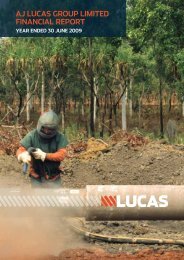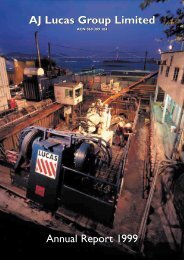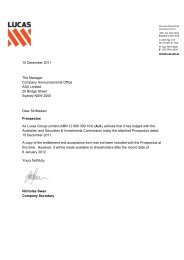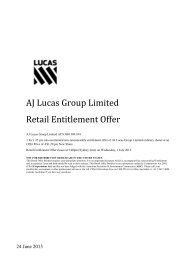AJ Lucas Group annual report 2007-08
AJ Lucas Group annual report 2007-08
AJ Lucas Group annual report 2007-08
You also want an ePaper? Increase the reach of your titles
YUMPU automatically turns print PDFs into web optimized ePapers that Google loves.
policies. Significant influence is presumed to exist when the <strong>Group</strong> holds<br />
between 20 and 50 percent of the voting power of another entity.<br />
Associates are accounted for using the equity method (equity<br />
accounted investees) and are initially recognised at cost. The <strong>Group</strong>’s<br />
investment includes goodwill identified on acquisition, net of any<br />
accumulated impairment losses. The consolidated financial statements<br />
include the <strong>Group</strong>’s share of income and expenses and equity movements<br />
of equity accounted investees, after adjustments to align the accounting<br />
policies with those of the <strong>Group</strong>, from the date that significant influence<br />
commences to the date that significant influence ceases. Where the<br />
<strong>Group</strong>’s share of losses exceeds its interest in an equity accounted<br />
investee, the carrying amount of that interest (including any long-term<br />
investments) is reduced to nil and the recognition of further losses is<br />
discontinued except to the extent that the <strong>Group</strong> has an obligation or has<br />
made payments on behalf of the investee.<br />
Subsidiaries: Subsidiaries are entities controlled by the <strong>Group</strong>.<br />
Control exists when the Company has the power, directly or indirectly, to<br />
govern the financial and operating policies of an entity so as to obtain<br />
benefits from its activities. In assessing control, potential voting rights that<br />
presently are exercisable or convertible are taken into account. The financial<br />
statements of subsidiaries are included in the consolidated financial<br />
statements from the date that control commences until the date that control<br />
ceases. The accounting policies of subsidiaries have been changed when<br />
necessary to align them with the policies adopted by the <strong>Group</strong>.<br />
Jointly controlled operations, assets and entities:<br />
The interest of the Company and of the <strong>Group</strong> in joint ventures and jointly<br />
controlled assets are brought to account by recognising in its financial<br />
statements the assets it controls, the liabilities that it incurs, the expenses<br />
it incurs and its share of income that it earns from the sale of goods or<br />
services by the joint venture.<br />
Transactions eliminated on consolidation: Intragroup<br />
balances, and any unrealised gains and losses or income and expenses<br />
arising from intragroup transactions, are eliminated in preparing<br />
the consolidated financial statements. Unrealised gains arising from<br />
transactions with equity accounted investees are eliminated against the<br />
investment to the extent of the <strong>Group</strong>’s interest in the investee. Unrealised<br />
losses are eliminated in the same way as unrealised gains, but only to the<br />
extent that there is no evidence of impairment.<br />
Foreign currency<br />
Foreign currency transactions: Transactions in foreign<br />
currencies are translated to the respective functional currencies of the<br />
<strong>Group</strong>’s entities at exchange rates at the dates of the transactions.<br />
Monetary assets and liabilities denominated in foreign currencies at the<br />
<strong>report</strong>ing date are retranslated to the functional currency at the foreign<br />
exchange rate at that date. The foreign currency gain or loss on monetary<br />
items is the difference between amortised cost in the functional currency<br />
at the beginning of the period, adjusted for effective interest and payments<br />
during the period, and the amortised cost in foreign currency translated<br />
at the exchange rate at the end of the period. Non-monetary assets and<br />
liabilities denominated in foreign currencies that are measured at fair<br />
value are retranslated to the functional currency at the exchange rate at<br />
the date that the fair value was determined. Foreign currency differences<br />
arising on retranslation are recognised in profit or loss.<br />
Foreign operations: The assets and liabilities of foreign operations<br />
are translated to Australian dollars at exchange rates at the <strong>report</strong>ing date.<br />
The income and expenses of foreign operations are translated to Australian<br />
dollars at exchange rates at the dates of the transactions.<br />
Foreign currency differences are recognised directly in equity. Since 1<br />
January 2004, the <strong>Group</strong>’s date of transition to AASBs, such differences<br />
have been recognised in the foreign currency translation reserve (‘FCTR’).<br />
When a foreign operation is disposed of, in part or in full, the relevant<br />
amount in the FCTR is transferred to profit or loss.<br />
Foreign exchange gains and losses arising from a monetary item<br />
receivable from or payable to a foreign operation, the settlement of which<br />
is neither planned nor likely in the foreseeable future, are considered to<br />
form part of the net investment in a foreign operation and are recognised<br />
directly in equity in the FCTR.<br />
Financial instruments<br />
Non-derivative financial instruments: Non-derivative<br />
financial instruments comprise trade and other receivables, cash and cash<br />
equivalents, loans and borrowings, and trade and other payables.<br />
Non-derivative financial instruments are recognised initially at fair<br />
value plus, for instruments not at fair value through profit or loss, any<br />
directly attributable transaction costs. Subsequent to initial recognition,<br />
non-derivative financial instruments are measured as described below.<br />
A financial instrument is recognised if the <strong>Group</strong> becomes a party<br />
to the contractual provisions of the instrument. Financial assets are<br />
derecognised if the <strong>Group</strong>’s contractual rights to the cash flows from<br />
the financial assets expire or if the <strong>Group</strong> transfers the financial asset<br />
to another party without retaining control or substantially all risks and<br />
rewards of the asset. Regular way purchases and sales of financial assets<br />
are accounted for at trade date, i.e., the date that the <strong>Group</strong> commits itself<br />
to purchase or sell the asset. Financial liabilities are derecognised if the<br />
<strong>Group</strong>’s obligations specified in the contract expire or are discharged or<br />
cancelled.<br />
Cash and cash equivalents comprise cash balances and call deposits.<br />
Bank overdrafts that are repayable on demand and form an integral part of<br />
the <strong>Group</strong>’s cash management are included as a component of cash and<br />
cash equivalents for the purpose of the statement of cash flows.<br />
Non-derivative financial instruments are measured at amortised cost<br />
using the effective interest method, less any impairment losses.<br />
Available-for-sale financial assets<br />
The <strong>Group</strong>’s investments in equity securities are classified as availablefor-sale<br />
financial assets. Subsequent to initial recognition, they are<br />
measured at fair value and changes therein, other than impairment<br />
losses are recognised directly in a separate component of equity. When<br />
an investment is derecognised, the cumulative gain or loss in equity is<br />
transferred to profit or loss.<br />
Compound financial instruments: Compound financial<br />
instruments issued by the <strong>Group</strong> comprise convertible notes that can be<br />
converted to share capital at the option of the holder, and the number of<br />
shares to be issued does not vary with changes in their fair value.<br />
The liability component of a compound financial instrument is<br />
recognised initially at the fair value of a similar liability that does not<br />
have an equity conversion option. The equity component is recognised<br />
initially at the difference between the fair value of the compound financial<br />
instrument as a whole and the fair value of the liability component. Any<br />
directly attributable transaction costs are allocated to the liability and<br />
equity components in proportion to their initial carrying amounts.<br />
Subsequent to initial recognition, the liability component of a<br />
compound financial instrument is measured at amortised cost using the<br />
effective interest method, unless it is designated at fair value through profit<br />
or loss. The equity component of a compound financial instrument is not<br />
remeasured subsequent to initial recognition.<br />
a year of milestones 35














